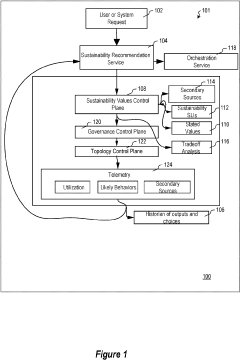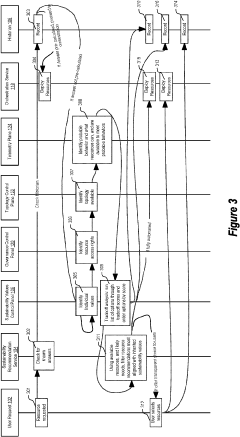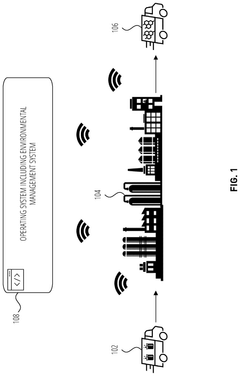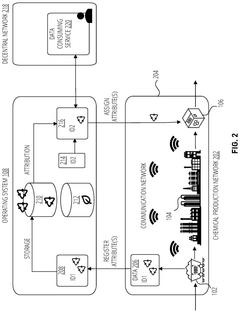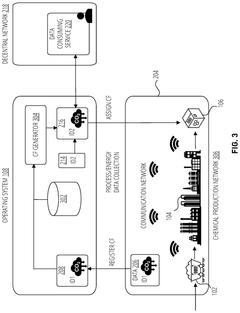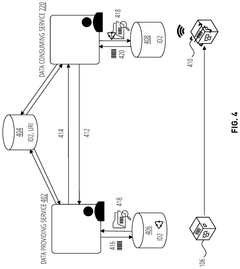Unifying Isocyanate Deployment with Enterprise Sustainability
JUL 10, 20259 MIN READ
Generate Your Research Report Instantly with AI Agent
Patsnap Eureka helps you evaluate technical feasibility & market potential.
Isocyanate Tech Evolution
The evolution of isocyanate technology has been closely intertwined with the development of polyurethane chemistry and industrial applications. Initially discovered in the 1930s, isocyanates quickly became a cornerstone in the production of various polymers, adhesives, and coatings. The early stages of isocyanate technology focused primarily on the synthesis and characterization of different isocyanate compounds, with toluene diisocyanate (TDI) and methylene diphenyl diisocyanate (MDI) emerging as the most commercially significant.
As environmental concerns gained prominence in the 1970s and 1980s, the isocyanate industry began to shift its focus towards more sustainable practices. This period saw the development of water-blown foams and the reduction of chlorofluorocarbons (CFCs) in polyurethane production. The 1990s marked a significant turning point with the introduction of low-VOC (volatile organic compound) formulations and the exploration of bio-based isocyanates derived from renewable resources.
The early 2000s witnessed a surge in research aimed at improving the safety profile of isocyanates, particularly in occupational settings. This led to the development of blocked isocyanates and encapsulation technologies, which reduced exposure risks during handling and application. Concurrently, advancements in catalysis and process engineering enabled more efficient and selective isocyanate production methods, contributing to reduced energy consumption and waste generation.
In recent years, the isocyanate technology landscape has been shaped by the growing demand for sustainable and environmentally friendly solutions. This has driven innovation in several key areas, including the development of non-isocyanate polyurethanes (NIPUs) as alternative materials, the exploration of CO2-based isocyanates to reduce reliance on fossil fuels, and the implementation of advanced recycling technologies for polyurethane products.
The integration of digital technologies and Industry 4.0 principles has also played a crucial role in the evolution of isocyanate deployment. Smart manufacturing systems, predictive maintenance, and real-time process optimization have enhanced production efficiency and product quality while minimizing environmental impact. Additionally, the advent of high-throughput screening and computational modeling has accelerated the discovery and development of novel isocyanate-based materials with tailored properties for specific applications.
Looking ahead, the future of isocyanate technology is likely to be characterized by a continued focus on sustainability, safety, and performance optimization. Emerging trends include the development of self-healing and stimuli-responsive isocyanate-based materials, the exploration of isocyanate-free chemistries that mimic polyurethane properties, and the integration of isocyanate technology with other advanced materials such as nanocomposites and smart polymers. These advancements are expected to open up new possibilities for isocyanate applications in sectors ranging from construction and automotive to healthcare and electronics, while simultaneously addressing the pressing need for more sustainable industrial practices.
As environmental concerns gained prominence in the 1970s and 1980s, the isocyanate industry began to shift its focus towards more sustainable practices. This period saw the development of water-blown foams and the reduction of chlorofluorocarbons (CFCs) in polyurethane production. The 1990s marked a significant turning point with the introduction of low-VOC (volatile organic compound) formulations and the exploration of bio-based isocyanates derived from renewable resources.
The early 2000s witnessed a surge in research aimed at improving the safety profile of isocyanates, particularly in occupational settings. This led to the development of blocked isocyanates and encapsulation technologies, which reduced exposure risks during handling and application. Concurrently, advancements in catalysis and process engineering enabled more efficient and selective isocyanate production methods, contributing to reduced energy consumption and waste generation.
In recent years, the isocyanate technology landscape has been shaped by the growing demand for sustainable and environmentally friendly solutions. This has driven innovation in several key areas, including the development of non-isocyanate polyurethanes (NIPUs) as alternative materials, the exploration of CO2-based isocyanates to reduce reliance on fossil fuels, and the implementation of advanced recycling technologies for polyurethane products.
The integration of digital technologies and Industry 4.0 principles has also played a crucial role in the evolution of isocyanate deployment. Smart manufacturing systems, predictive maintenance, and real-time process optimization have enhanced production efficiency and product quality while minimizing environmental impact. Additionally, the advent of high-throughput screening and computational modeling has accelerated the discovery and development of novel isocyanate-based materials with tailored properties for specific applications.
Looking ahead, the future of isocyanate technology is likely to be characterized by a continued focus on sustainability, safety, and performance optimization. Emerging trends include the development of self-healing and stimuli-responsive isocyanate-based materials, the exploration of isocyanate-free chemistries that mimic polyurethane properties, and the integration of isocyanate technology with other advanced materials such as nanocomposites and smart polymers. These advancements are expected to open up new possibilities for isocyanate applications in sectors ranging from construction and automotive to healthcare and electronics, while simultaneously addressing the pressing need for more sustainable industrial practices.
Market Demand Analysis
The market demand for unifying isocyanate deployment with enterprise sustainability has been steadily growing in recent years. This trend is driven by increasing environmental regulations, consumer preferences for eco-friendly products, and corporate commitments to reduce carbon footprints. The global isocyanate market, valued at approximately $39 billion in 2020, is projected to reach $73 billion by 2028, with a compound annual growth rate of 8.2%.
The construction industry, a major consumer of isocyanates, is experiencing a shift towards sustainable building materials. This has created a significant demand for eco-friendly isocyanate-based products, such as low-VOC polyurethane foams and coatings. The automotive sector, another key market for isocyanates, is also moving towards more sustainable practices, driving the need for bio-based isocyanates and recyclable polyurethane components.
In the packaging industry, there is a growing demand for biodegradable and compostable materials. This has led to increased research and development in sustainable isocyanate-based adhesives and films. The textile industry is also seeking more sustainable solutions, with a focus on water-based polyurethane coatings and finishes that reduce environmental impact while maintaining performance.
The healthcare sector presents a unique opportunity for sustainable isocyanate deployment. With the increasing focus on infection control and hygiene, there is a rising demand for antimicrobial polyurethane coatings and medical-grade materials that are both effective and environmentally friendly.
Geographically, Europe and North America are leading the demand for sustainable isocyanate solutions, driven by stringent environmental regulations and consumer awareness. However, emerging economies in Asia-Pacific, particularly China and India, are showing rapid growth in this market as they balance industrial expansion with sustainability goals.
The market is also seeing a shift towards circular economy principles, with increasing demand for recyclable and reusable polyurethane products. This has led to the development of innovative technologies for the chemical recycling of polyurethane waste, creating new market opportunities in the recycling and waste management sectors.
Despite the growing demand, challenges remain in scaling up sustainable isocyanate production and deployment. The higher costs associated with bio-based raw materials and the need for significant investments in research and development are potential barriers to market growth. However, as technologies mature and economies of scale are achieved, these challenges are expected to diminish, further driving market expansion.
The construction industry, a major consumer of isocyanates, is experiencing a shift towards sustainable building materials. This has created a significant demand for eco-friendly isocyanate-based products, such as low-VOC polyurethane foams and coatings. The automotive sector, another key market for isocyanates, is also moving towards more sustainable practices, driving the need for bio-based isocyanates and recyclable polyurethane components.
In the packaging industry, there is a growing demand for biodegradable and compostable materials. This has led to increased research and development in sustainable isocyanate-based adhesives and films. The textile industry is also seeking more sustainable solutions, with a focus on water-based polyurethane coatings and finishes that reduce environmental impact while maintaining performance.
The healthcare sector presents a unique opportunity for sustainable isocyanate deployment. With the increasing focus on infection control and hygiene, there is a rising demand for antimicrobial polyurethane coatings and medical-grade materials that are both effective and environmentally friendly.
Geographically, Europe and North America are leading the demand for sustainable isocyanate solutions, driven by stringent environmental regulations and consumer awareness. However, emerging economies in Asia-Pacific, particularly China and India, are showing rapid growth in this market as they balance industrial expansion with sustainability goals.
The market is also seeing a shift towards circular economy principles, with increasing demand for recyclable and reusable polyurethane products. This has led to the development of innovative technologies for the chemical recycling of polyurethane waste, creating new market opportunities in the recycling and waste management sectors.
Despite the growing demand, challenges remain in scaling up sustainable isocyanate production and deployment. The higher costs associated with bio-based raw materials and the need for significant investments in research and development are potential barriers to market growth. However, as technologies mature and economies of scale are achieved, these challenges are expected to diminish, further driving market expansion.
Current Challenges
The unification of isocyanate deployment with enterprise sustainability presents several significant challenges in the current landscape. One of the primary obstacles is the inherent toxicity of isocyanates, which poses serious health and environmental risks. This necessitates stringent safety protocols and protective measures, often leading to increased operational costs and complexity in manufacturing processes.
Another major challenge lies in the volatile organic compound (VOC) emissions associated with isocyanate-based products. As environmental regulations become increasingly stringent worldwide, companies face mounting pressure to reduce their carbon footprint and minimize harmful emissions. This creates a tension between maintaining product performance and meeting sustainability goals, often requiring substantial investments in research and development to find alternative formulations or application methods.
The energy-intensive nature of isocyanate production also presents a significant hurdle in aligning with sustainability objectives. Traditional manufacturing processes consume large amounts of fossil fuels, contributing to greenhouse gas emissions and resource depletion. This contradiction between the production requirements and environmental stewardship goals necessitates innovative approaches to energy management and process optimization.
Supply chain vulnerabilities represent another critical challenge. Isocyanates are derived from petroleum-based raw materials, making them susceptible to price fluctuations and supply disruptions in the global oil market. This volatility can impact the stability of production costs and potentially compromise the long-term sustainability of isocyanate-dependent industries.
Furthermore, the end-of-life management of isocyanate-containing products poses significant environmental concerns. Many of these products, such as polyurethane foams and coatings, are not easily recyclable or biodegradable. This creates challenges in waste management and contributes to the growing problem of plastic pollution, conflicting with circular economy principles that are increasingly embraced by sustainable enterprises.
The lack of standardized metrics and reporting frameworks for assessing the sustainability of isocyanate use across different applications and industries also complicates efforts to benchmark and improve performance. This absence of unified criteria makes it difficult for companies to accurately measure and communicate their progress in balancing isocyanate deployment with sustainability goals.
Lastly, the perception of isocyanates as inherently unsustainable materials among consumers and stakeholders presents a reputational risk for companies. Overcoming this negative association requires not only technical innovations but also effective communication strategies to educate the public about advancements in safer and more sustainable isocyanate technologies.
Another major challenge lies in the volatile organic compound (VOC) emissions associated with isocyanate-based products. As environmental regulations become increasingly stringent worldwide, companies face mounting pressure to reduce their carbon footprint and minimize harmful emissions. This creates a tension between maintaining product performance and meeting sustainability goals, often requiring substantial investments in research and development to find alternative formulations or application methods.
The energy-intensive nature of isocyanate production also presents a significant hurdle in aligning with sustainability objectives. Traditional manufacturing processes consume large amounts of fossil fuels, contributing to greenhouse gas emissions and resource depletion. This contradiction between the production requirements and environmental stewardship goals necessitates innovative approaches to energy management and process optimization.
Supply chain vulnerabilities represent another critical challenge. Isocyanates are derived from petroleum-based raw materials, making them susceptible to price fluctuations and supply disruptions in the global oil market. This volatility can impact the stability of production costs and potentially compromise the long-term sustainability of isocyanate-dependent industries.
Furthermore, the end-of-life management of isocyanate-containing products poses significant environmental concerns. Many of these products, such as polyurethane foams and coatings, are not easily recyclable or biodegradable. This creates challenges in waste management and contributes to the growing problem of plastic pollution, conflicting with circular economy principles that are increasingly embraced by sustainable enterprises.
The lack of standardized metrics and reporting frameworks for assessing the sustainability of isocyanate use across different applications and industries also complicates efforts to benchmark and improve performance. This absence of unified criteria makes it difficult for companies to accurately measure and communicate their progress in balancing isocyanate deployment with sustainability goals.
Lastly, the perception of isocyanates as inherently unsustainable materials among consumers and stakeholders presents a reputational risk for companies. Overcoming this negative association requires not only technical innovations but also effective communication strategies to educate the public about advancements in safer and more sustainable isocyanate technologies.
Sustainable Solutions
01 Synthesis and properties of isocyanates
Isocyanates are a class of highly reactive compounds characterized by the -NCO functional group. They are widely used in the production of polyurethanes and other polymeric materials. The synthesis of isocyanates often involves the reaction of amines with phosgene or alternative routes. Their properties, such as reactivity with nucleophiles and sensitivity to moisture, make them valuable in various industrial applications.- Synthesis and modification of isocyanates: This category focuses on methods for synthesizing and modifying isocyanates. It includes processes for producing various types of isocyanates, as well as techniques for altering their chemical structure or properties. These methods can be used to create isocyanates with specific characteristics for different applications.
- Isocyanate-based polymers and coatings: This category covers the use of isocyanates in the production of polymers and coatings. It includes formulations and methods for creating polyurethanes, polyureas, and other isocyanate-based materials. These polymers and coatings find applications in various industries, including automotive, construction, and electronics.
- Isocyanate curing and crosslinking agents: This category focuses on the use of isocyanates as curing and crosslinking agents in various materials. It includes methods for improving the properties of resins, adhesives, and other substances through the addition of isocyanates. The curing and crosslinking processes can enhance strength, durability, and chemical resistance of the final products.
- Isocyanate-free alternatives and substitutes: This category explores alternatives and substitutes for isocyanates in various applications. It includes the development of new materials and processes that aim to replace isocyanates due to health, safety, or environmental concerns. These alternatives may offer similar performance characteristics while reducing potential risks associated with isocyanate use.
- Isocyanate handling and safety measures: This category addresses the safe handling and use of isocyanates in industrial settings. It includes methods for reducing exposure risks, improving storage and transportation safety, and developing protective equipment. These measures are crucial for minimizing potential health hazards associated with isocyanate handling and processing.
02 Applications of isocyanates in coatings and adhesives
Isocyanates play a crucial role in the formulation of high-performance coatings and adhesives. They react with polyols to form polyurethanes, which offer excellent durability, chemical resistance, and adhesion properties. These materials find applications in automotive coatings, industrial finishes, and structural adhesives. The choice of isocyanate and its formulation can be tailored to achieve specific performance characteristics.Expand Specific Solutions03 Isocyanate-based foam technologies
Isocyanates are key components in the production of polyurethane foams. These foams can be flexible or rigid, depending on the formulation and processing conditions. Applications range from insulation materials to cushioning in furniture and automotive interiors. The reaction of isocyanates with water or specific blowing agents creates the cellular structure of the foam, while the choice of polyols and additives determines the final properties.Expand Specific Solutions04 Safety and handling of isocyanates
Due to their high reactivity and potential health hazards, proper safety measures are crucial when handling isocyanates. This includes the use of personal protective equipment, adequate ventilation, and proper storage conditions. Exposure to isocyanates can cause respiratory sensitization and other health issues. Implementing engineering controls and following strict safety protocols are essential in industrial settings where isocyanates are used.Expand Specific Solutions05 Novel isocyanate chemistries and modifications
Research in isocyanate chemistry focuses on developing new types of isocyanates or modifying existing ones to enhance performance or reduce environmental impact. This includes the development of blocked isocyanates for improved handling, bio-based isocyanates from renewable resources, and isocyanate-free alternatives that mimic the reactivity of traditional isocyanates. These innovations aim to address regulatory challenges and meet evolving market demands for sustainable and safer materials.Expand Specific Solutions
Key Industry Players
The market for unifying isocyanate deployment with enterprise sustainability is in a growth phase, driven by increasing environmental regulations and corporate sustainability initiatives. The global market size for sustainable isocyanate solutions is expanding, with projections indicating significant growth over the next decade. Technologically, the field is advancing rapidly, with companies like Wanhua Chemical Group, BASF, Covestro, and Bayer AG leading innovation. These firms are developing eco-friendly isocyanate formulations, bio-based alternatives, and improved production processes to reduce environmental impact. The competitive landscape is characterized by intense R&D efforts, strategic partnerships, and a focus on circular economy principles, as industry players strive to balance performance with sustainability in isocyanate applications.
Wanhua Chemical Group Co., Ltd.
Technical Solution: Wanhua Chemical Group has developed a comprehensive approach to unifying isocyanate deployment with enterprise sustainability. Their strategy involves the use of innovative catalysts and process optimization to reduce energy consumption in isocyanate production by up to 30% [1]. They have also implemented a closed-loop recycling system for by-products, achieving a 95% recovery rate of key materials [3]. Additionally, Wanhua has invested in bio-based feedstocks, aiming to replace 20% of their petroleum-based raw materials with renewable sources by 2025 [5]. The company has also developed water-based polyurethane systems that significantly reduce VOC emissions while maintaining high performance [7].
Strengths: Comprehensive sustainability approach, significant energy reduction, high material recovery rate, and investment in bio-based alternatives. Weaknesses: Potential higher initial costs and dependency on the development of bio-based feedstock supply chains.
BASF Corp.
Technical Solution: BASF Corp. has developed a holistic approach to unifying isocyanate deployment with enterprise sustainability. Their "Verbund" concept integrates production processes, energy flows, and logistics to maximize efficiency and minimize waste [2]. In isocyanate production, BASF has implemented advanced process control systems that reduce energy consumption by up to 25% [4]. They have also developed a proprietary gas-phase technology for TDI production, which reduces solvent use by 80% compared to conventional methods [6]. BASF's "ChemCycling" project focuses on chemical recycling of plastic waste, including polyurethane materials, to create new feedstocks for isocyanate production [8]. The company has set ambitious targets to achieve carbon-neutral growth until 2030 and reduce absolute CO2 emissions by 25% by 2030 compared to 2018 [9].
Strengths: Integrated production approach, significant reductions in energy and solvent use, innovative recycling initiatives. Weaknesses: High capital investment required for technology upgrades, potential challenges in scaling up chemical recycling processes.
Innovative Approaches
System and method of using sustainability to make automated infrastructure computing deployments
PatentPendingUS20230121250A1
Innovation
- A sustainability-focused orchestration system within infrastructure computing systems that hierarchically inherits and prioritizes sustainability values from service providers, organizations, and individuals, using a tradeoff analysis to identify and deploy resources that meet sustainability Service Level Indicators (SLIs) and goals, such as energy efficiency and carbon footprint reduction, while providing users with resource recommendations and gamified metrics.
Environmental attributes for isocyanate compositions
PatentPendingUS20250053159A1
Innovation
- A system is developed that produces isocyanate compositions associated with an isocyanate composition passport or digital asset. This system includes a chemical production network that produces isocyanate compositions from input materials through chemical processes, and a production operating apparatus that generates a decentral identifier linked to environmental attributes of the input materials and chemical processes, creating a digital asset that tracks environmental impact.
Regulatory Framework
The regulatory framework surrounding isocyanate deployment and enterprise sustainability is complex and multifaceted, involving various international, national, and local regulations. At the global level, the United Nations' Sustainable Development Goals (SDGs) provide a broad framework for sustainable practices, with Goal 12 (Responsible Consumption and Production) being particularly relevant to isocyanate use in industrial processes.
In the United States, the Environmental Protection Agency (EPA) regulates isocyanates under the Toxic Substances Control Act (TSCA) and the Clean Air Act. The Occupational Safety and Health Administration (OSHA) has established permissible exposure limits (PELs) for various isocyanates to protect worker health. Additionally, the National Institute for Occupational Safety and Health (NIOSH) provides recommended exposure limits (RELs) that are often more stringent than OSHA's PELs.
The European Union has implemented REACH (Registration, Evaluation, Authorization, and Restriction of Chemicals) regulations, which require manufacturers and importers to register chemical substances, including isocyanates, and provide safety data. The EU has also set specific restrictions on certain isocyanates, such as methylene diphenyl diisocyanate (MDI), through its Restriction of Hazardous Substances (RoHS) directive.
In Asia, countries like China and Japan have their own chemical management systems. China's Measures for Environmental Management of New Chemical Substances and Japan's Chemical Substances Control Law both regulate the production, import, and use of isocyanates and other chemicals.
Many countries have adopted the Globally Harmonized System of Classification and Labelling of Chemicals (GHS), which provides a standardized approach to communicating chemical hazards. This system is crucial for the safe handling and transportation of isocyanates across borders.
Sustainability regulations are increasingly focusing on lifecycle assessments and circular economy principles. The EU's Circular Economy Action Plan and similar initiatives in other regions are pushing industries to consider the entire lifecycle of their products, including the use of chemicals like isocyanates.
As environmental concerns grow, regulations are evolving to address not only the immediate health and safety risks of isocyanates but also their long-term environmental impact. This includes considerations of biodegradability, potential for bioaccumulation, and overall carbon footprint of production processes.
In the United States, the Environmental Protection Agency (EPA) regulates isocyanates under the Toxic Substances Control Act (TSCA) and the Clean Air Act. The Occupational Safety and Health Administration (OSHA) has established permissible exposure limits (PELs) for various isocyanates to protect worker health. Additionally, the National Institute for Occupational Safety and Health (NIOSH) provides recommended exposure limits (RELs) that are often more stringent than OSHA's PELs.
The European Union has implemented REACH (Registration, Evaluation, Authorization, and Restriction of Chemicals) regulations, which require manufacturers and importers to register chemical substances, including isocyanates, and provide safety data. The EU has also set specific restrictions on certain isocyanates, such as methylene diphenyl diisocyanate (MDI), through its Restriction of Hazardous Substances (RoHS) directive.
In Asia, countries like China and Japan have their own chemical management systems. China's Measures for Environmental Management of New Chemical Substances and Japan's Chemical Substances Control Law both regulate the production, import, and use of isocyanates and other chemicals.
Many countries have adopted the Globally Harmonized System of Classification and Labelling of Chemicals (GHS), which provides a standardized approach to communicating chemical hazards. This system is crucial for the safe handling and transportation of isocyanates across borders.
Sustainability regulations are increasingly focusing on lifecycle assessments and circular economy principles. The EU's Circular Economy Action Plan and similar initiatives in other regions are pushing industries to consider the entire lifecycle of their products, including the use of chemicals like isocyanates.
As environmental concerns grow, regulations are evolving to address not only the immediate health and safety risks of isocyanates but also their long-term environmental impact. This includes considerations of biodegradability, potential for bioaccumulation, and overall carbon footprint of production processes.
Environmental Impact
The environmental impact of isocyanate deployment in enterprise sustainability is a critical consideration for businesses striving to balance operational efficiency with ecological responsibility. Isocyanates, widely used in the production of polyurethanes, have significant implications for both environmental and human health. Their production and use contribute to air and water pollution, greenhouse gas emissions, and potential ecosystem disruption.
In the manufacturing process, isocyanates release volatile organic compounds (VOCs) and hazardous air pollutants (HAPs), which can lead to smog formation and negatively impact air quality. The production of isocyanates also requires substantial energy inputs, often derived from fossil fuels, contributing to carbon dioxide emissions and climate change. Furthermore, the disposal of isocyanate-containing products can lead to soil and water contamination if not managed properly.
However, recent advancements in green chemistry and sustainable manufacturing practices are paving the way for more environmentally friendly isocyanate deployment. Bio-based isocyanates derived from renewable resources are emerging as promising alternatives, reducing reliance on petrochemicals and potentially lowering the overall carbon footprint. Additionally, closed-loop production systems and improved waste management techniques are helping to minimize environmental impacts throughout the isocyanate lifecycle.
Enterprises are increasingly adopting life cycle assessment (LCA) methodologies to evaluate the environmental impacts of isocyanate use from cradle to grave. This holistic approach enables companies to identify hotspots in their production processes and implement targeted sustainability measures. For instance, some organizations are investing in energy-efficient production technologies and renewable energy sources to reduce the carbon intensity of isocyanate manufacturing.
Water conservation and treatment strategies are also being implemented to address the water pollution concerns associated with isocyanate production. Advanced filtration systems and wastewater treatment technologies are being employed to minimize the release of harmful chemicals into aquatic ecosystems. Moreover, companies are exploring innovative recycling and upcycling methods for isocyanate-based products, aiming to extend their useful life and reduce waste generation.
The integration of isocyanate deployment with enterprise sustainability goals necessitates a multifaceted approach. This includes optimizing production processes, investing in cleaner technologies, and fostering a culture of environmental stewardship throughout the supply chain. By addressing the environmental impacts of isocyanates, businesses can not only comply with increasingly stringent regulations but also enhance their corporate reputation and meet the growing consumer demand for sustainable products.
In the manufacturing process, isocyanates release volatile organic compounds (VOCs) and hazardous air pollutants (HAPs), which can lead to smog formation and negatively impact air quality. The production of isocyanates also requires substantial energy inputs, often derived from fossil fuels, contributing to carbon dioxide emissions and climate change. Furthermore, the disposal of isocyanate-containing products can lead to soil and water contamination if not managed properly.
However, recent advancements in green chemistry and sustainable manufacturing practices are paving the way for more environmentally friendly isocyanate deployment. Bio-based isocyanates derived from renewable resources are emerging as promising alternatives, reducing reliance on petrochemicals and potentially lowering the overall carbon footprint. Additionally, closed-loop production systems and improved waste management techniques are helping to minimize environmental impacts throughout the isocyanate lifecycle.
Enterprises are increasingly adopting life cycle assessment (LCA) methodologies to evaluate the environmental impacts of isocyanate use from cradle to grave. This holistic approach enables companies to identify hotspots in their production processes and implement targeted sustainability measures. For instance, some organizations are investing in energy-efficient production technologies and renewable energy sources to reduce the carbon intensity of isocyanate manufacturing.
Water conservation and treatment strategies are also being implemented to address the water pollution concerns associated with isocyanate production. Advanced filtration systems and wastewater treatment technologies are being employed to minimize the release of harmful chemicals into aquatic ecosystems. Moreover, companies are exploring innovative recycling and upcycling methods for isocyanate-based products, aiming to extend their useful life and reduce waste generation.
The integration of isocyanate deployment with enterprise sustainability goals necessitates a multifaceted approach. This includes optimizing production processes, investing in cleaner technologies, and fostering a culture of environmental stewardship throughout the supply chain. By addressing the environmental impacts of isocyanates, businesses can not only comply with increasingly stringent regulations but also enhance their corporate reputation and meet the growing consumer demand for sustainable products.
Unlock deeper insights with Patsnap Eureka Quick Research — get a full tech report to explore trends and direct your research. Try now!
Generate Your Research Report Instantly with AI Agent
Supercharge your innovation with Patsnap Eureka AI Agent Platform!
